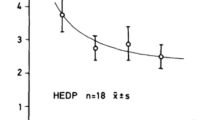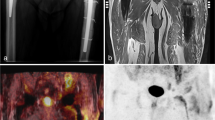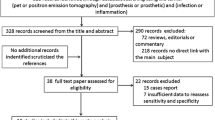Abstract
Introduction
To diagnose septic and aseptic loosening 18-fluorodeoxyglucose positron emission tomography (18F-FDG-PET) has been described with good results for hip arthroplasties. The purpose of the present study was to examine whether there is a difference of feasibility in detecting loosening of hip versus knee prostheses by use of 18F-FDG-PET.
Patients
Thirty-two patients with lower limb arthroplasty complaints (74 components) were studied preoperatively with 18F-FDG-PET. The interpretation of 18F-FDG-PET was done according to evaluated criteria. The final diagnosis based on intraoperative findings in all cases including microbiological examinations.
Results
For hip arthroplasty sensitivity/specificity of 18F-FDG-PET towards implant loosening was 80%/87%. For infectious loosening of hip endoprostheses sensitivity/specificity was 67%/83%. In knee endoprostheses sensitivity/specificity for loosening was 56%/82% and 14%/89% for infection. The sensitivity of the results for knee and hip joints in regard to infectious versus aseptic loosening was significantly different.
Conclusion
We confirm that 18F-FDG-PET is an appropriate tool to diagnose hip arthroplasty loosening. Differing from that 18F-FDG-PET showed a significant lower sensitivity/specificity in detecting septic loosening of knee endoprostheses. It may therefore be necessary to use different methods to diagnose loosening of endoprostheses depending on the type of implant which is examined.




Similar content being viewed by others
References
Barrack RL, Jennings RW, Wolfe MW, Bertot AJ (1997) The Coventry award: the value of preoperative aspiration before total knee revision. Clin Orthop Relat Res 345:8–16
Bernard L, Lubbeke A, Stern R, Bru JP, Feron JM, Peyramond D, Denormandie P, Arvieux C, Chirouze C, Perronne C, Hoffmeyer P (2004) Value of preoperative investigations in diagnosing prosthetic joint infection: retrospective cohort study and literature review. Scand J Infect Dis 36(6–7):410–416
Chacko TK, Zhuang H, Stevenson K, Moussavian B, Alavi A (2002) The importance of the location of fluorodeoxyglucose uptake in periprosthetic infection in painful hip. Nucl Med Commun 23(9):851–855
Chryssikos T, Parvizi J, Ghanem E, Newberg A, Zhuang H, Alavi A (2008) FDG-PET Imaging can diagnose periprosthetic infection of the hip. Clin Orthop Relat Res 466:1338–1342
Cremerius U, Mumme T, Reinartz P, Wirtz D, Niethard FU, Buell U (2003) Analysis of 18F-FDG uptake patterns in PET for diagnosis of septic and aseptic loosening after total hip arthroplasty. Nuklearmedizin 42:234–239
Fitzgerald RH Jr (1995) Diagnosis and management of the infected hip prosthesis. Orthopedics 18(9):833–835
Furnes O, Lie SA, Espehaug B, Vollset SE, Engesaeter LB, Havelin LI (2001) Hip disease and the prognosis of total hip replacements. A review of 53.698 primary total hip replacements reported to the Norwegian Arthroplasty Register 1987–1999. J Bone Joint Surg Br 83(4):579–586
Herberts P, Malchau H (2000) Long term registration has improved the quality of hip replacement a review of the Swedish THR Register comparing 160.000 cases. Acta Orthop Scand 71(2):111–121
Keogh CF, Munk PL, Gee R, Chan LP, Marchinkow LO (2003) Imaging of the painful hip arthroplasty. Am J Roentgenol 180(1):115–120
Kisielinski K, Cremerius U, Bull U, Hermanns B, Wirtz DC, Niethard FU (2003) First experiences with fluorodeoxyglucose-positron-emission tomography (FDG-PET) in the evaluation of painful total knee and hip joint replacements. Z Orthop Ihre Grenzgeb 141(2):153–159
Kisielinski K, Cremerius U, Reinartz P, Niethard FU (2003) Fluordeoxyglucose positron emission tomography detection of inflammatory reactions due to polyethylene wear in total hip arthroplasty. Athroplasty 18(4):528–532
Love C, Marwin S, Tomas M, Krauss E, Tronco G, Bhargava K, Nichols K, Palestro C (2004) Diagnosing infection in the failed joint replacement: a comparison of coincidence detection 18F-FDG and 111In-labeled leukocytes/99 m Tc-sulfur colloid marrow imaging. J Nucl Med 45(11):1864–1871
Love C, Pugliese PV, Afriyie MO, Tomas MB, Marwin SE, Palestro CJ (2000) Utility of F-18 FDG Imaging for diagnosing the infected joint replacement. Clin Positron Imaging 3(4):159
Mulamba L, Ferrant A, Leners N, de Nayer P, Rombouts JJ, Vincent A (1983) Indium–111 leucocyte scanning in the evaluation of painful hip arthroplasty. Acta Orthop Scand. 54(5):695–697
Mumme T, Cremerius U, Hermanns B, Neuss M, Müller-Rath R, Buell U, Wirtz DC (2003) FDG PET as an early nuclear medical diagnostic tool for aseptic wear-induced loosening of hip joint endoprotheses. Unfallchirurg 106:592–599
Mumme T, Reinartz J, Alfer J, Müller-Rath R, Buell U, Wirtz DC (2005) Diagnostic values of positron emission tomography versus triple phase bone scan in hip arthroplasty loosening. Arch Orthop Trauma Surg 125:322–329
Reinartz P, Mumme T, Hermanns B, Cremerius U, Wirtz DC, Schaefer WM, Niethard FU, Buell U (2005) Radionuclide imaging of the painful hip arthroplasty: positron-emission tomography versus triple-phase bone scanning. J Bone Joint Surg Br 87(4):465–470
Stumpe KD, Notzli HP, Zanetti M, Kamel EM, Hany TF, Gorres GW, von Schulthess GK, Hodler J (2004) FDG PET for differentiation of infection and aseptic loosening in total hip replacements: comparison with conventional radiography and three-phase bone scintigraphy. Radiology 231(2):333–341
Stumpe KD, Romero J, Ziegler O, Kamel EM, von Schulthess GK, Strobel K, Hodler J (2006) The value of FDG-PET in patients with painful total knee arthroplasty. Eur J Nucl Med 33:1218–1225
Trampuz A, Piper KE, Jacobson MJ, Hanssen AD, Unni KK, Osmon DR, Mandrekar JN, Cockerill FR, Steckelberg JM, Green Leaf JF, Patel R (2007) Sonication of removed hip and knee prostheses for diagnosis of infection. N Engl J Med 357(7):654–663
Van Acker F, Nuyts J, Maes A, Vanquickenborne B, Stuyck J, Bellemans J, Vleugels S, Bornemans G, Mortelmans L (2001) FDG-PET, 99mTc-HMPAO white blood cell SPECT and bone scintigraphy in the evaluation of painful total knee arthroplasties. Eur J Nucl Med 28:1496–1504
Vanquickenborne B, Maes A, Nuyts J, Van Acker F, Stuyck J, Mulier M, Verbruggen A, Mortelmans L (2003) The value of 18FDG-PET for the detection of infected hip prosthesis. Eur J Nucl Med Mol Imaging 30(5):705–715
Zhuang H, Duarte PS, Pourdehnad M, Maes A, Van Acker F, Shnier D, Garino JP, Fitzgerald RH, Alavi A (2001) The promising role of 18F-FDG PET in detecting infected lower limb prosthesis implants. J Nucl Med 42(1):44–48
Zoccali C, Teori G, Salducca N (2008) The role of FDG-PET in distinguishing between septic and aseptic loosening in hip prosthesis: a review of literature. Int Orthop 32:567–571
Conflict of interest statement
None declared.
Author information
Authors and Affiliations
Corresponding author
Rights and permissions
About this article
Cite this article
Mayer-Wagner, S., Mayer, W., Maegerlein, S. et al. Use of 18F-FDG-PET in the diagnosis of endoprosthetic loosening of knee and hip implants. Arch Orthop Trauma Surg 130, 1231–1238 (2010). https://doi.org/10.1007/s00402-009-1000-z
Received:
Published:
Issue Date:
DOI: https://doi.org/10.1007/s00402-009-1000-z




